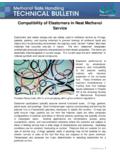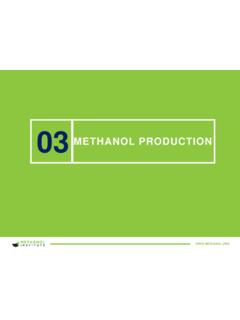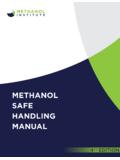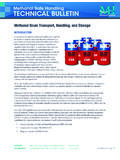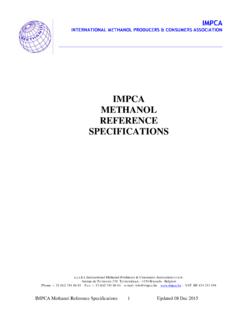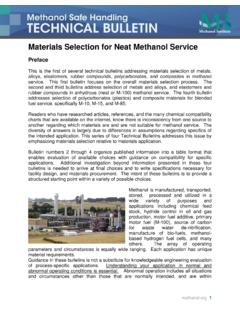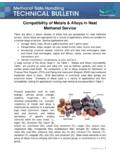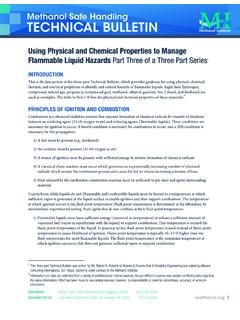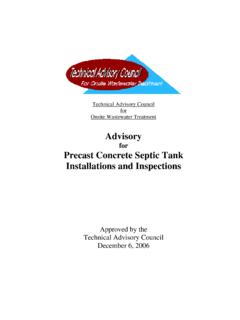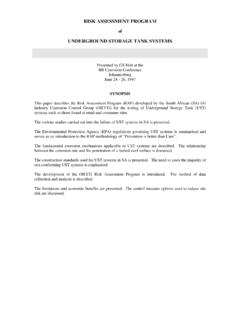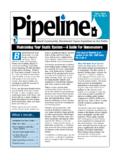Transcription of Atmospheric Above Ground Tank Storage of …
1 Atmospheric Above Ground Tank Storage of Methanol INTRODUCTION. Guidelines for designing, fabricating, constructing, repairing, and safeguarding Above - Ground methanol Storage tanks is essentially the same as that for liquid transportation fuels such as ethanol and gasoline, and flammable liquid feed stocks such as benzene, acetone, and toluene. However, physical and chemical properties of methanol are unique to methanol and are not the same as those of other bulk-stored flammable liquids. Some considerations of tank Storage are unique to methanol. One important consideration is flammability range.
2 Because the upper flammability limit of methanol is 36. percent by volume (vol%) compared to that of gasoline which is 6-7 vol%, methanol vapor can ignite and burn inside tank vapor space. Corrosion is another consideration. Methanol is a conductive polar solvent; gasoline is a non-conductive, non-polar solvent. Galvanic and dissimilar metal corrosion in methanol service may be high if incompatible materials are placed in electrical contact with one another. Cathodic protection, and regulator inspection of methanol Storage tanks and trim hardware is vitally important to avoid corrosion failure.
3 Principal considerations of tank Storage of methanol are siting, liquid and vapor containment, electrical grounding, cathodic protection, protection from stray currents, in-tank vapor control, vapor space fire suppression, and management of inhalation, ingestion, and dermal contact. Methanol Institute recommends that users familiarize themselves with relevant codes and standards, and devise and implement a disciplined layers of protection program to prevent spills, accidental release, overpressure, ignition, and fire suppression. It is essential that fire detection, alarm, response, and suppression be rapid and effective.
4 Guidance for design, fabrication, construction, and tank safety are available in American Petroleum Institute (API). publications: API Standard 620, Design and Construction of Large, Welded, Low-Pressure Storage tanks API Standard 653, Tank Inspection, Repair, Alteration, and Reconstruction. Provisions for siting, electrical grounding, berming, and safeguarding Above Ground Storage tanks containing flammable liquids are given by the International Code Council (ICC) and the National Fire Protection Agency (NFPA). Guidelines are available in: NFPA 1 Uniform Fire Code NFPA 30, Flammable and Combustible Liquids Code.
5 SINGAPORE Suntec Tower Three 8 Temasek Blvd Singapore 038988 + WASHINGTON DC 4100 North Fairfax Drive, Suite 740, Arlington, VA 22203 1 Atmospheric Above Ground Tank Storage of Methanol (Continued). Considerations not addressed in the Above -sited references are specific to methanol Storage , namely, Materials selection Purity protection Fire prevention, suppression and spill containment. TANK MATERIALS OF CONSTRUCTION & TRIM MATERIALS COMPATIBILITY. Methanol is classified by the International Code Council and the National Fire Protection Agency as a class IB.
6 Flammable liquid. Other IB liquids are ethanol, hydrocarbon fuels such as gasoline and kerosene, and reactants such as benzene, acetone, and toluene. No. 1 diesel, No. 2 diesel, and biodiesel are classified as combustible motor fuels, and are also handled and stored in Above Ground Atmospheric Storage tanks . Methanol gasoline fuel blends are subject to phase separation in the presence of water. Methanol and water, two polar compounds, form a mixture which separates from gasoline, a non-polar mixture of C4 thru C12 hydrocarbons. Methanol boils at 149 F; gasoline boils over a range of temperatures extending from < 140 to 390 F.
7 Methanol tanks can be constructed of either carbon steel or 300 series austenitic stainless steel. Carbon steel has the advantage of lower capital cost, but the disadvantage of higher life cycle cost due to increased maintenance and costs associated with corrosion protection. Because methanol is a polar solvent, galvanic corrosion is more prevalent with methanol than with other commonly-used motor fuels. Because of its very high affinity to form mixtures with water, methanol is hygroscopic and extracts moisture from ambient air that enters tank vapor space during normal liquid level cycling.
8 In the presence of neat or technical grade methanol, the small amount of water added by desiccation of Atmospheric air does not substantially increase the rate of general corrosion. Never-the-less, because of the relatively high conductivity of liquid methanol, corrosion induced failures of carbon steel tanks have been reported. Efforts to coat interior tank surfaces with epoxy resin have met with limited success. Typical coating life is less than seven years, and the coatings tend to form an electrically non-conductive barrier between the methanol and the tank, thereby complicating bonding and grounding.
9 Recent reports indicate progress is being made in developing more suitable electrically conductive spray- on tank liner coatings. Galvanic corrosion of dissimilar trim materials may be accelerated in methanol service, particularly trim materials of aluminum, lead, magnesium, copper, zinc and platinum alloys. An example of this resulted in a methanol tank fire when the aluminum alloy flame_arrester corroded to the point of being non-functional. The Chemical Safety Board concluded that the flame arrester did not prevent the fire outside the tank from igniting the tank contents.
10 Routine inspections would have detected the corrosion in the flame_arrester that occurred over 12 years. The use of an aluminum flame arrester in methanol service coupled with the lack of inspection and maintenance allowed the flame arrester to corrode to the point that it no longer functioned.. Galvanized steel is not suitable for methanol service. If the methanol-water mixture forms within a gasoline-methanol blend and separates from the gasoline as a separate phase, then localized corrosion may be accelerated. If the water phase accumulates chloride salts due to proximity to a coastal environment, then under-deposit corrosion, localized pitting corrosion, and crevice corrosion may be accelerated.

